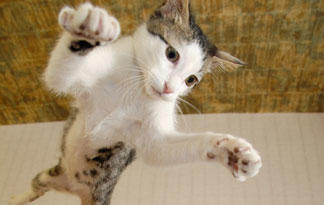BECCA’S CATS
***This cache is not at the posted coordinates! To find the cache just answer this question. ***
Mrs. Becca is our local cat expert. The Becca cat’s series was placed in honor of her. She has a unique way of loving your friends and family that be those with two legs or four. Please enjoy this series as it will grow into a geo art when it is done.
Why do cats land on their feet?

Whether myth, miracle or marvel of physics, the idea of a cat always landing on his feet is firmly embedded in feline lore. It's as if cats possess invisible landing gear, and no matter their size, they can turn a tumble into a right-side up touchdown. Tabbies overshooting windowsills in quest of passing birds, or miscalculating fences as they run from barking dogs, appear to regain perfect balance without effort, an action that long baffled observers -- until frame-by-frame photos, and video in slow motion, unveiled the details of this uncanny feline habit.
That's not to say cats land without harm. Falling cats do sometimes suffer injuries, and not all cats survive falls, particularly older, less agile ones. Thanks to science and technology, here's what else we now know about cats' aerodynamic abilities.
Fact or Fiction?
Most of the time, a cat will land on his feet when he falls. His body reflexively corrects its course so that by the time he arrives on the ground, his feet are in position to hit first. The height of a cat's fall determines how well, or how poorly, his legs can absorb the shock of landing.
Veterinarians treating the broken legs and other injuries of cats that survive falls from high-rise apartments noticed that the cats who fell from greater heights, such as more than five stories, often suffered less severe injuries than those falling from just a few floors because the longer drop gave the cats' bodies more time to right themselves.
Feline Body Mechanics
Seen in slow motion, a falling cat begins to shift his balance from the second his flight begins. His body determines which side should be up, and he begins rotating his head, directed by his eyes and ears, until he's facing that way. Next his spine follows as he arches his back; then his front feet, followed by his hind legs, get positioned under him, with his front paws placed close to his face to spare it from the ground's impact. As he lands, the cat's leg joints bear the impact of his weight. A falling cat is less like an airplane and more like a parachute. As his body orients itself to the falling motion, it relaxes and spreads out for the landing ahead.
Cats are also gifted in other ways for landing on their feet. They are born with flexible backbones that enable that course correction while falling. Cats also have 30 vertebrae, which contributes to their suppleness (humans have just 24). And while their tails often act as rudders in daily activities, tails are insignificant in freefall -- so even a cat born without a tail, such as the Manx, or the unlucky feline who's lost his to injury can still navigate a fall.
The cat's inner ear houses his vestibular system, which tells the cat's body where it is in relation to the ground, whether upside down, in motion, or walking around. The system lets the cat's body correctly orient itself and regain balance after a fall.
Inborn or Learned Behavior?
A cat's ability to land on his feet isn't a trick taught by his mother or life experience, but is a gift of nature. By the time kittens are about 6 weeks old and able to run and jump in a coordinated way, their bodies can successfully correct their balance during a fall.
However, your cat still needs to be protected from the risk of falling. If you have some open windows in your high-rise apartment or upstairs in your house, be sure they are properly screened. And teach your kids to be gentle with their pet. Some children are naturally curious and may be tempted to toss the cat from the second floor to see if cats really land on their feet. Talk to them about the potential of hurting Kitty, particularly when the drop is fairly low, and let them watch a video online if they really want to see the process in action.
What is the longest non-fatal fall?
9 floor N 30° 36.125' W 85° 26.625'
12 floor N 30° 36.055' W 85° 26.612'
16 floor N 30° 36.078' W 85° 26.614'